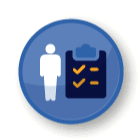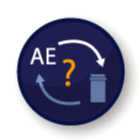Touch the icons on each side to learn more
-
 Pre-specified patient poolTrial participants are selected according to
Pre-specified patient poolTrial participants are selected according to
pre-specified eligibility criteria2,3 -
 Controlled trialsIn randomized controlled trials (RCTs), incidence of AEs with a product is compared with a control (eg, placebo)4-6
Controlled trialsIn randomized controlled trials (RCTs), incidence of AEs with a product is compared with a control (eg, placebo)4-6 -
 Types of adverse events (AEs) reportedIn clinical trials, all AEs are reported for the study duration (including controlled and open-label phases) regardless of causality2,3,5,6-8
Types of adverse events (AEs) reportedIn clinical trials, all AEs are reported for the study duration (including controlled and open-label phases) regardless of causality2,3,5,6-8
- Heterogeneous patient populationA larger and more heterogenous patient population use the approved/marketed product in the real-world setting (eg, patients with more complex comorbidities)9,10

- Challenges in assessing causalityEstablishing whether a causal relationship exists between real-world AEs and the drug is challenging because:
- There may be unidentified or unaccounted for confounding factors10
- The incidence of real-world AEs includes background rates of the affected population10

- Types of AEs reportedIn the post-marketing setting, the manufacturer must communicate all AEs that are reported to them to regulatory agencies regardless of causality11

- Regulatory agency reporting timelinesAEs are communicated to regulatory agencies according to specified timelines11,12

Although AEs reported in the real world may differ from those in clinical trials,
together these help reflect the product safety profile13